With each stroke of the hand plane, the sculpted lines of stripped cedar planks take form. In this room, just a few miles off the coast, the salt-etched hands of the boat builder move across the bow as he hones his craft. He is focused on necessity in that the structure must float and withstand the pounding waves of a fast-approaching New England winter; he is focused on usefulness in that this vessel will carry men, cargo, or food; and he is focused on aesthetics, drawing out the beauty found within the lines of the carefully selected grain of the wood. This is Maine at the end of the 18th century, where a legacy of boat-building has already long taken root, and the lush forests provide the means for the skilled craftsman to fulfill the end—handmade ships and boats worthy of a lifetime at sea. However, it will be over 200 years before the saplings of these same lands will be harvested to be made necessary, useful, and beautiful in the hands of modern-day craftsmen with another end in mind: surfing.
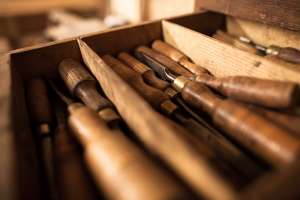
Mike LaVecchia, Brad Anderson, and the crew at Grain Surfboards don’t just make surfboards. At their home in the town of York, 10 miles inland, give or take, from the coast of Maine, co-owners LaVecchia and Anderson have channeled a kind of Shaker mentality for finding a sense of higher purpose through the practice of one’s craft. The exclusivity of the Grain brand adorning their handmade wooden surfboards would lead one to think that the coveted methodology behind their custom boards would remain a mystery, like a secret family recipe, locked up and passed on through the bond of blood. But Grain wants to pass this knowledge on, sharing the technique in a communal setting, forming a bond between creator and creation, and inspiring the hands of future craftsmen for generations to come.

When you mention surfing to most people, flashes of Endless Summer come to mind—warm sunny beaches of California and Australia, board shorts, and scantily-clad beauties lining sandy beaches. But coastal New England? Not at the top of mind for most. Mike, Brad and the crew are changing that notion for many people with their take on what a surfboard should be, and what the creation of the board should mean to its rider. The polyurethane foam board, an early design from the 1950s that grew in popularity towards the last few decades of the 20th century, appealed to the mass market due to its affordability and significant weight reduction over the solid wood surfboards that surfing’s pioneers started on. While easily manufactured, little to no care was paid to the environmental ramifications of producing these boards, and what they made up for in cost, they lacked in personality and soul.
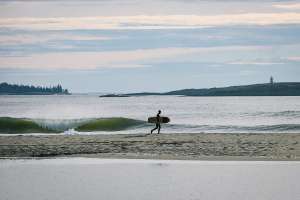
With time spent as a former boatbuilder, Mike LaVecchia believed the age-old methods he had practiced could be applied to his passion for surfing. LaVecchia, who formerly worked for Burton snowboards, set up a makeshift shop in his basement in York, Maine, and began experimenting with designs for hollow-core wooden surfboards using traditional boat-building techniques. He soon met Brad Anderson, a craftsman with an expertise in woodworking, and they perfected the methods with which they could build their boards. With over 200 miles of coastline and several hundred years of boat-building and craftsman history, Maine made the perfect home for Grain Surfboards.
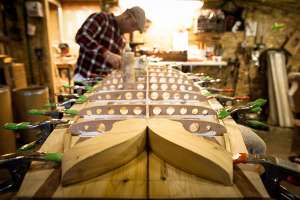
Hollow-core wooden boards were not a new concept, having been experimentally built and used in the 1930s and ‘40s as a transition away from solid (and heavy) wooden boards, which people had been surfing for thousands of years. But LaVecchia and Anderson wanted to improve upon the classic board shapes by applying modern techniques to build a stronger, lighter wooden surfboard that looked as good as it performed. Much like the wing of a plane, the boards are monocoque in design. A system of wooden frames inside is covered with cedar planks and railstrips forming a strong outer skin, which is then sanded, shaped, and fiberglassed for water resistance. The finished board is reminiscent of finely-crafted furniture; it features a high polish, and every grain of the rough-sawn cedar is visible, like the veins of a workhorse. Its visual weight is equally intimidating, but holding it reveals the opposite to be true: while anything but delicate, it’s light, airy, and nimble.
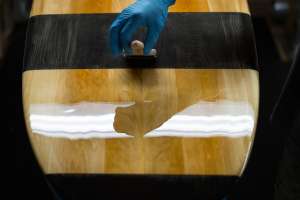
Despite the old New England adage, “you can’t get there from here,” Grain has arrived, and done so with an unassuming quiet charm that embodies the ethos of this region. There is no showboating, no brash neon flashing colors boasting their presence. Just a simple humility blended with a fervent drive to make something meaningful. Having outgrown the simple basement operation it once was, Grain is now located on a small farm in York, overlooking the rolling hills of the Maine countryside and with a growing staff.
LaVecchia and Anderson are adamant about keeping sustainability core to their business. The surfboards are made from rough-sawn northern white cedar, grown in northern Maine, and any refuse from the process during which the boards are made is put to good use, such as the shavings from the shaping process being given to the farm owner for animal bedding. What you find here is the antithesis of the fast-paced, “hustle or be trampled” competitive market. The decision to establish themselves on a farm in rural Maine was a deliberate one, free of distraction, and allowed the artisans to focus on honing their craft.
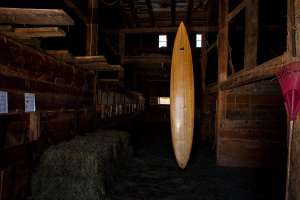
Knowledge that is coveted will eventually become lost, and no one understands this better than Grain. They offer classes throughout the year, sharing the techniques and methods for creating their custom boards, and allowing participants to leave with a complete Grain creation. Giving students the opportunity to carve every line on their own board – to know the intricacies of the wood and experience the labor-intensive process through which it was made – connects them to the object in a way that can not be achieved through the purchase of a mass-produced foam board. Grain hosts students from around the globe who spend up to a week in Maine for these classes, but Grain understands that education can’t only happen in York.
At one point, LaVecchia and Anderson hit the road on motorcycles, using Brad’s 1971 BMW R90, with a sidecar modified to carry boards and materials, to do a mobile demo tour along the East Coast. Eventually, they invested in an old bread truck (one used by its previous owner to transport motorcycles). After a long period of restoration, the truck became a temporary mobile classroom. Recently, through the support of the Kickstarter community, Grain raised the funds needed to build a true mobile classroom in which they can sleep, teach, and travel safely to expand the reach of their education as far as the West Coast.

Happiness comes in all forms, and Grain understands the inherent desire in all of us to create something more meaningful. We all strive for this in our daily lives, through the turning of a wrench on our two-wheeled escape vehicles, and with every pass of the hand plane on a freshly formed seafaring vessel. Each project is taken on with a desire for the same end: freedom. Whether by road or by sea, freedom is in our souls and in our veins, and burning to be let out.
Anyone can buy a motorcycle and ride it, or hop on a pre-made board and slide along a wall of water. However, Grain is delivering that transcendental experience we all seek by bridging the gap between rider and board, creator and creation, satisfying our need for necessity, usefulness and beauty for the escape we all hope to make.
